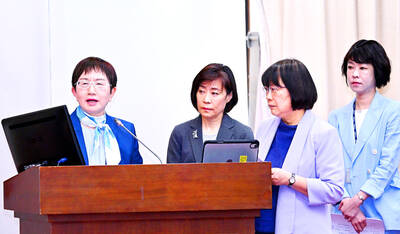The nation’s electrical engineering and machinery industry could consider Southeast Asia as a market for new demand, the Taiwan Institute of Economic Research (TIER, 台灣經濟研究院) said last week.
Given the region’s stable economic growth, demand from Southeast Asian countries would be more favorable in the long term, TIER senior analyst Wang Chung-ching (王忠慶) told a seminar organized by Taiwan Stock Exchange Corp (台灣證券交易所) on Wednesday.
As demand in Taiwan is unlikely to increase significantly in the near future, manufacturers need to seek new sales drivers in emerging markets while the government could help manufacturers find new buyers via existing channel networks, as many Taiwanese companies have operated in Southeast Asia for years, Wang said.
Taiwan’s exports of machinery equipment dropped 6.9 percent to US$19.4 billion last year from a year earlier, the fourth consecutive year of decline, data compiled by the Taiwan Association of Machinery Industry (TAMI, 台灣機械工業同業公會) showed.
Shipments to China and the US, the top two markets for local machinery makers, declined by 12.7 percent and 0.6 percent year-on-year last year respectively, TAMI’s data showed.
China was the destination for about 26 percent of all Taiwanese machinery exports last year, followed by the US, with 17.9 percent, while Southeast Asia accounted for 16.7 percent or US$3.24 billion, the TAMI data showed.
“The machinery industry’s exports have been stagnant since 2011, mainly dragged down by the sluggish demand after the global financial crisis [2008 to 2009],” Wang said, adding that challenges also comes from the supply side.
Local manufacturers face a rising competition from their global peers, such as Germany and China, who have used new technologies to enhance their capabilities.
Germany, which initiated the idea of “Industry 4.0” in 2011, has extended its focus to the computerization of manufacturing process in all its industrial sectors, Wang said.
Foreign exchange fluctuation is another drag on Taiwan’s exports, he said.
The dramatic depreciation of China’s yuan against major global currencies significantly hurt the industry last year, he added.
Local manufacturers should boost their niches in the global market through product differentiation, he said.
“Most machinery companies only provide individual machines or components. They should try to develop total solutions for end-market customers,” he said.
To raise the competitiveness of the nation’s traditional industries, the Taiwan Machine Tool & Accessory Builders’ Association (台灣工具機暨零組件工業同業公會) has said that it is seeking to cooperate with companies in different fields, including the semiconductor industry, to differentiate their products from those of their rivals.

‘SWASTICAR’: Tesla CEO Elon Musk’s close association with Donald Trump has prompted opponents to brand him a ‘Nazi’ and resulted in a dramatic drop in sales Demonstrators descended on Tesla Inc dealerships across the US, and in Europe and Canada on Saturday to protest company chief Elon Musk, who has amassed extraordinary power as a top adviser to US President Donald Trump. Waving signs with messages such as “Musk is stealing our money” and “Reclaim our country,” the protests largely took place peacefully following fiery episodes of vandalism on Tesla vehicles, dealerships and other facilities in recent weeks that US officials have denounced as terrorism. Hundreds rallied on Saturday outside the Tesla dealership in Manhattan. Some blasted Musk, the world’s richest man, while others demanded the shuttering of his

ADVERSARIES: The new list includes 11 entities in China and one in Taiwan, which is a local branch of Chinese cloud computing firm Inspur Group The US added dozens of entities to a trade blacklist on Tuesday, the US Department of Commerce said, in part to disrupt Beijing’s artificial intelligence (AI) and advanced computing capabilities. The action affects 80 entities from countries including China, the United Arab Emirates and Iran, with the commerce department citing their “activities contrary to US national security and foreign policy.” Those added to the “entity list” are restricted from obtaining US items and technologies without government authorization. “We will not allow adversaries to exploit American technology to bolster their own militaries and threaten American lives,” US Secretary of Commerce Howard Lutnick said. The entities

Minister of Finance Chuang Tsui-yun (莊翠雲) yesterday told lawmakers that she “would not speculate,” but a “response plan” has been prepared in case Taiwan is targeted by US President Donald Trump’s reciprocal tariffs, which are to be announced on Wednesday next week. The Trump administration, including US Secretary of the Treasury Scott Bessent, has said that much of the proposed reciprocal tariffs would focus on the 15 countries that have the highest trade surpluses with the US. Bessent has referred to those countries as the “dirty 15,” but has not named them. Last year, Taiwan’s US$73.9 billion trade surplus with the US

Prices of gasoline and diesel products at domestic gas stations are to fall NT$0.2 and NT$0.1 per liter respectively this week, even though international crude oil prices rose last week, CPC Corp, Taiwan (台灣中油) and Formosa Petrochemical Corp (台塑石化) said yesterday. International crude oil prices continued rising last week, as the US Energy Information Administration reported a larger-than-expected drop in US commercial crude oil inventories, CPC said in a statement. Based on the company’s floating oil price formula, the cost of crude oil rose 2.38 percent last week from a week earlier, it said. News that US President Donald Trump plans a “secondary